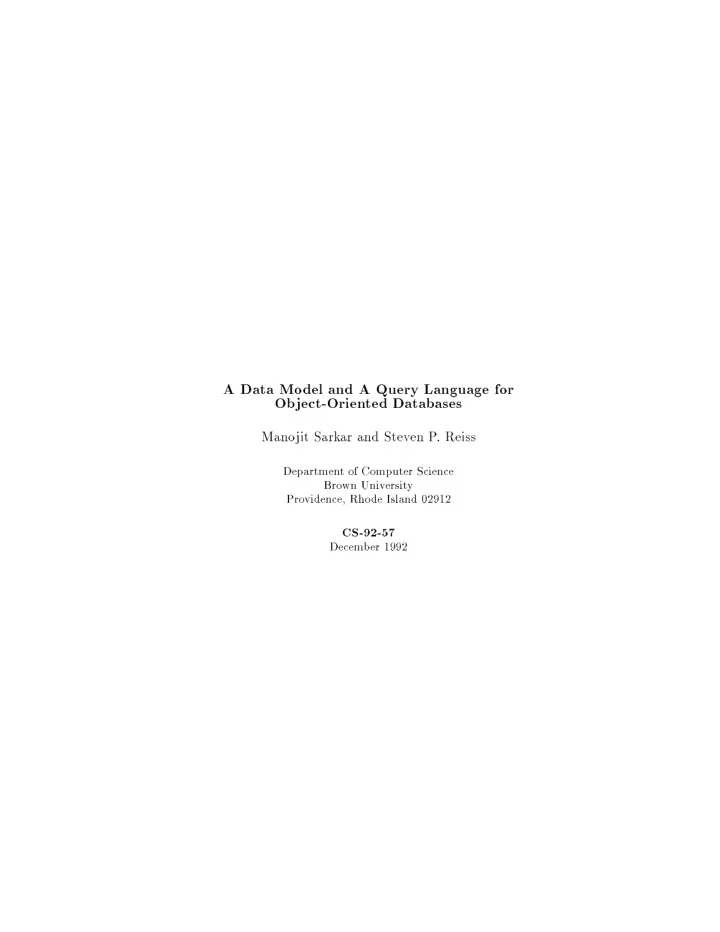

A Data Mo del and A Query Language for Ob ject-Orien ted Databases Mano jit Sark ar and Stev en P . Reiss Departmen t of Computer Science Bro wn Univ ersit y Pro vidence, Rho de Island 02912 CS-92-57 Decem b er 1992
� A Data Mo del and A Query Language for Ob ject-Orien ted Databases Mano jit Sark ar Stev en P . Reiss Departmen t of Computer Science Bro wn Univ ersit y Pro vidence, RI 02912 USA Abstract mo del, and a query language to b e used with our pro- gram visualization system. W e presen t an ob ject-orien ted data mo del, and a p o w- The query language presen ted in this pap er is named erful declarativ e query language. The data mo del elimi- OQL (Ob ject Query Language). OQL is declarativ e, and nates the obje ct-versus-values dic hotom y b y represen ting highly expressiv e. W e use the query language for b oth all en tities as ob jects. This is ac hiev ed at no loss of mo d- de�nition and generation of abstractions. A declarativ e eling p o w er, or p erformance. The data mo del pro vides language can mak e this tasks easier. Our goal is to de- for priv ate o wnership of ob jects b y other ob jects. The v elop a language that is nearly as easy or more easy to op erational part of the data mo del is also simple. W e use than SQL. Higher expressiv e p o w er is desirable b e- presen t a rule-based query language called OQL (Ob- cause that allo ws generation of wider range of abstrac- ject Query Language) based on the data mo del. OQL tions. creates and manipulates ob jects without explicitly re- Our mapping from abstraction ob jects to their graph- ferring to ob ject iden ti�ers. It is statically t yp ed, and ical visualization is t yp e-based. All the generated ab- capable of creating new ob jects of arbitrary t yp es. It can stractions therefore m ust ha v e a t yp e. Also, to pro vide express recursiv e queries, eliminate duplicates, manipu- e�ectiv e program visualization, our system m ust ha v e late mixture of tuple-v alued, set-v alued and list-v alued the capabilit y to generate abstractions that are not ex- ob jects, and express queries in v olving inheritance trees. pressed b y existing relationships in the database. OQL W e presen t an ob ject-algebra, an assignmen t op erator, is therefore designed for creating ob jects of an y arbitrary and a REPEA T UNTIL lo op construct whic h are used t yp e, and the users can de�ne a new t yp e at an y time. to implemen t OQL. Reduction of OQL to algebra, as- signmen t op eration, and lo op construct, and reduction of algebra, assignmen t op eration, and lo op construct to 2 Con tributions OQL are also discussed. The data mo del presen ted in this pap er represen ts all en- tities as ob jects. The system uses in ternally generated 1 Motiv ation obje ct identi�ers for giving ob jects their unique iden tit y . An ob ject also has a state, and a b eha vior. Eac h ob ject W e started in v estigating ob ject-orien ted database sys- b elongs to a class. The class de�nes the structure of the tems for constructing abstract information ab out pro- ob ject's state, and its b eha vior. Classes are organized grams, called pr o gr am abstr actions , b y retrieving infor- in inheritance hierarc h y . An ob ject of a class � can b e mation from some form of stored represen tation of pro- used where an ob ject of � 's sup erclass is exp ected. Inher- grams, called pr o gr am datab ase . The idea is to generate itance p olymorphism is pro vided through late binding of abstractions b y querying the database, the answ ers to metho ds based on actual classes of ob jects. the queries are the target abstractions. These abstrac- Our data mo del is conceptually simple. It a v oids tions are subsequen tly visualized graphically , and our the obje cts-versus-values dic hotom y found in other data 1 full system is a pr o gr am visualization system . mo dels suc h as in [11 , 12 , 3, 8]. This is ac hiev ed at no The data mo del of our full program visualization sys- extra cost. W e also sho w that it is p ossible to satisfy a tem is ob ject-orien ted, and w e w an ted a database with v ariet y of data mo deling requiremen ts suc h as values of a compatible data mo del. This pap er presen ts a data O , c omp osite obje cts of ORION [4 , 10], and own r ef ob- 2 � Supp ort for this researc h w as pro vided b y NSF gran ts jects of EX ODUS within the ob ject-orien ted paradigm. CCR9111507 and CCR9113226, b y ARP A order 8225 and b y ONR The conceptual simplicit y of the data mo del do es not im- gran t N00014-91-J-40 52 1 ply lo w er p erformance. It is p ossible to engineer in ternal Readers in terested in our program visualization system are referred to [16 ] optimizations for go o d p erformance. 1
Recommend
More recommend